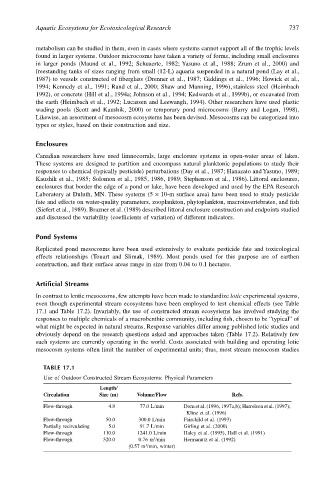Page 757 - The Toxicology of Fishes
P. 757
Aquatic Ecosystems for Ecotoxicological Research 737
metabolism can be studied in them, even in cases where systems cannot support all of the trophic levels
found in larger systems. Outdoor microcosms have taken a variety of forms, including small enclosures
in larger ponds (Maund et al., 1992; Schuaerte, 1982; Yasuno et al., 1988; Zrum et al., 2000) and
freestanding tanks of sizes ranging from small (12-L) aquaria suspended in a natural pond (Lay et al.,
1987) to vessels constructed of fiberglass (Drenner et al., 1987; Giddings et al., 1996; Howick et al.,
1994; Kennedy et al., 1991; Rand et al., 2000; Shaw and Manning, 1996), stainless steel (Heimbach
1992), or concrete (Hill et al., 1994a; Johnson et al., 1994; Kedwards et al., 1999b), or excavated from
the earth (Heimbach et al., 1992; Lucassen and Leewangh, 1994). Other researchers have used plastic
wading pools (Scott and Kaushik, 2000) or temporary pond microcosms (Barry and Logan, 1998).
Likewise, an assortment of mesocosm ecosystems has been devised. Mesocosms can be categorized into
types or styles, based on their construction and size.
Enclosures
Canadian researchers have used limnocorrals, large enclosure systems in open-water areas of lakes.
These systems are designed to partition and encompass natural planktonic populations to study their
responses to chemical (typically pesticide) perturbations (Day et al., 1987; Hanazato and Yasuno, 1989;
Kaushik et al., 1985; Solomon et al., 1985, 1986, 1989; Stephenson et al., 1986). Littoral enclosures,
enclosures that border the edge of a pond or lake, have been developed and used by the EPA Research
Laboratory at Duluth, MN. These systems (5 × 10-m surface area) have been used to study pesticide
fate and effects on water-quality parameters, zooplankton, phytoplankton, macroinvertebrates, and fish
(Siefert et al., 1989). Brazner et al. (1989) described littoral enclosure construction and endpoints studied
and discussed the variability (coefficients of variation) of different indicators.
Pond Systems
Replicated pond mesocosms have been used extensively to evaluate pesticide fate and toxicological
effects relationships (Touart and Slimak, 1989). Most ponds used for this purpose are of earthen
construction, and their surface areas range in size from 0.04 to 0.1 hectares.
Artificial Streams
In contrast to lentic mesocosms, few attempts have been made to standardize lotic experimental systems,
even though experimental stream ecosystems have been employed to test chemical effects (see Table
17.1 and Table 17.2). Invariably, the use of constructed stream ecosystems has involved studying the
responses to multiple chemicals of a macrobenthic community, including fish, chosen to be “typical” of
what might be expected in natural streams. Response variables differ among published lotic studies and
obviously depend on the research questions asked and approaches taken (Table 17.2). Relatively few
such systems are currently operating in the world. Costs associated with building and operating lotic
mesocosm systems often limit the number of experimental units; thus, most stream mesocosm studies
TABLE 17.1
Use of Outdoor Constructed Stream Ecosystems: Physical Parameters
Length/
Circulation Size (m) Volume/Flow Refs.
Flow-through 4.9 77.0 L/min Dorn et al. (1996, 1997a,b); Harrelson et al. (1997);
Kline et al. (1996)
Flow-through 50.0 300.0 L/min Fairchild et al. (1993)
Partially recirculating 5.0 91.7 L/min Girling et al. (2000)
Flow-through 110.0 1241.0 L/min Haley et al. (1995), Hall et al. (1991)
3
Flow-through 520.0 0.76 m /min Hermanutz et al. (1992)
(0.57 m /min, winter)
3

